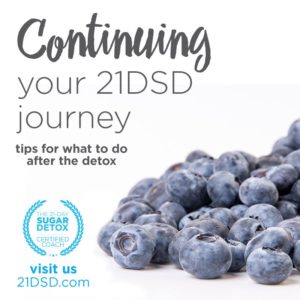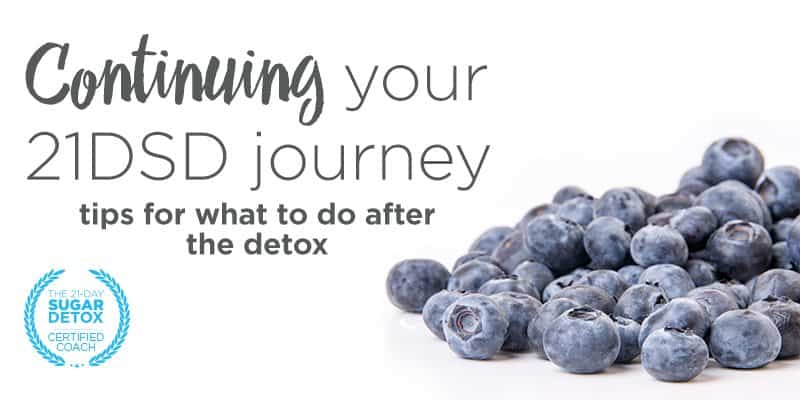Hey Folks! We're excited to welcome back Certified 21DSD Coach Beth Romanski. Beth's article is part of a series contributed by our Certified 21DSD Coaches. Enjoy! – Diane and Team
Congratulations on making it through your 21DSD and for committing yourself to consistent healthier eating!
While there is something magical about the timeframe of 21 days that is supposed to form new habits, the real work often begins after your nutrition challenge. In fact, I frequently tell my clients that it’s often easier to be on a strict diet with very clear “rules” to follow because it takes the thinking out of your choices that inevitably come up in everyday life. So the true challenge begins post-detox or nutrition challenge when you want to maintain your progress while living a full, balanced life. This is the reason why I’ve adapted my 21DSD group programs to include a bonus session to give my participants even more support transitioning post-detox and why I’m offering a comprehensive wellness program exclusively for my 21DSD group alumni. Being healthy is a lifelong process.
Are you feeling the same type of anxiety ending your detox as you did starting out? Not to fear! This is a learning process, so here are a few tips for you to consider at this stage in your journey:
 Don’t fear the blueberry.
Don’t fear the blueberry.
You may chuckle when I say this, but you wouldn’t believe how many clients start to question adding back in “No” foods that are otherwise real food and perfectly healthy, such as berries. There are some foods that are certainly better not to reintroduce as regular components of your long-term diet, such as gluten, wheat, processed foods, and added sugars; but when it comes down to it, the 21DSD is an elimination diet, so it’s not meant for you to adhere to so strictly that you should never have anything other than the “Yes” foods. Not sure where to start? Check out this great article by Diane Sanfilippo about what foods to reintroduce and which to ditch for good.
Utilize the 21DSD Post-Detox Guide.
This is an invaluable resource that you should use to strategically experiment with reintroducing foods. Having a plan is helpful too, particularly if you’re coming from an Autoimmune modification. There is no one “perfect” diet, but you can find the one that works for YOU at this stage in your life. I specialize in helping my clients create their own Personal Nutrition Blueprints, but you have the power to do this for yourself with a little time and effort. If you do need more help figuring things out, working with a Health Coach is a good option, too.
Make a list of your successes and embrace your new lifestyle.
Write down all the things that improved as a result of your detox experience. There’s something about putting pen to paper that makes it official and easier to remember if you’re tempted to slide back into old ways. Keep this in your wallet or on your fridge so it’s in the front of your mind whenever you feel tempted.
Figure out if you are an Abstainer or Moderator.
Some coaches introduce this concept by Gretchen Rubin at the beginning of your detox, but it’s even more important at the end when your options are more open. Moderators can have small amount of healthy treats (or any foods that may cause cravings or triggers) without falling into a pattern of overindulgence, whereas Abstainers do better leaving them out of their regular diet entirely for peace of mind.
If you are mostly an Abstainer, but want to have more variety on occasion, another strategy is to set very specific allowances for healthy treats, such as “I will only have one piece of gluten-free chocolate cake on my birthday, if I decide I want it at that time,” or “I will only have one coconut flour donut on the first Sunday of every month during a special brunch with my family, if I decide I want it at that time.” All other days of the year you’re not having the cake or donut (but still healthier versions of both). If you don’t know which type of person you are, you can take the free quiz here.
Continue to expand your palate.
Hopefully you’ve come to love many new “Yes” foods, but there is no reason why you can’t continue trying new foods and recipes that you didn’t get to in a short 21 days’ timeframe. I like to challenge my clients to try 1-2 new foods or recipes every week. Soon they’ve expanded their palate immensely from where they started.
Be a role model for others.
I don’t recommend preaching or scolding others for their choices, but if someone has a genuine interest, then share the program and a few of your healthy recipes; you never know who you can positively influence through your choices and actions. You can also submit your testimonial to inspire others to give the program a try.
Continue to work on lifestyle factors.
Good health certainly revolves around food, but lifestyle factors are almost more important to overall wellness after you get your diet on track; so make it a point to work further on stress management, mindfulness, positive social connections, more play and joy, reducing environmental toxins, getting proper rest, and appropriate exercise.
Do another round of the 21DSD at a different level.
Even though I’m a Certified 21DSD Coach, I don’t advocate constantly going off and on nutrition challenges because it feeds the “yo-yo diet” mentality. On the other hand, doing another round of the 21DSD program at another Level can help you solidify what you've learned and further your knowledge abut how your body responds to different foods. For example, move from Level 1 to Level 2 to eliminate dairy, or go from Level 3 back to Level 2 to see how your body responds once you are in a better state of overall health and can tolerate a wider variety of “Yes” foods.
Work with a Certified 21DSD Coach and keep learning.
Even after all the education I received to earn my certification as an Integrative Health Coach, I’m still learning something new about nutrition and wellness every single day. When you work with a Certified 21-Day Sugar Detox Coach, we bring an entirely new experience to the program through our education sessions and advanced knowledge. I tailor my program to my group and clients so they can learn much more than they could on their own, or they can work on individualized health goals. You can search for a Certified 21SDSD Coach that works online or in your area, or by various specializations here.
In the end, life is meant to be enjoyed. While I don’t want to minimize all your success during the past 21 days, the journey is only beginning…and remember, we’re always here to support you as a member of our 21DSD community!
 Beth Romanski is a Certified Health Coach and graduate of the Institute for Integrative Nutrition. Beth takes a personalized approach to health coaching, working with clients to create custom nutrition blueprints and individualized coaching programs to meet their needs. Beth is passionate about spreading the message of health and happiness through education, with a supportive and empowering style.
Beth Romanski is a Certified Health Coach and graduate of the Institute for Integrative Nutrition. Beth takes a personalized approach to health coaching, working with clients to create custom nutrition blueprints and individualized coaching programs to meet their needs. Beth is passionate about spreading the message of health and happiness through education, with a supportive and empowering style.
Visit Beth’s website at www.myhealthytransitions.com to learn more about her one-on-one coaching programs, to sign up for the MyHealthyTransitions email newsletter, or to request a complimentary health coach phone consultation as a special offer for 21DSD Blog readers.


Comments 1
Pingback: Paleo Pitfalls | What's Up Weekly with Diane | July 5th, 2017